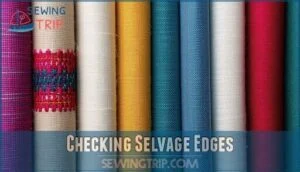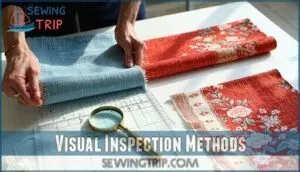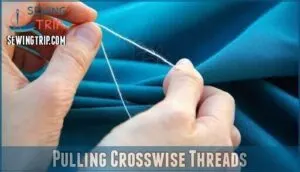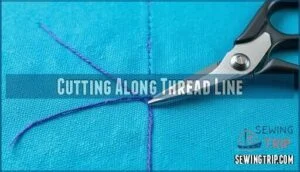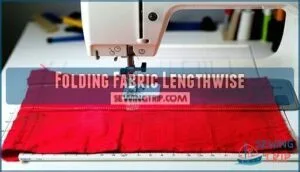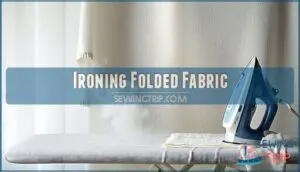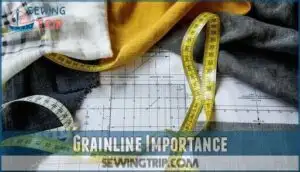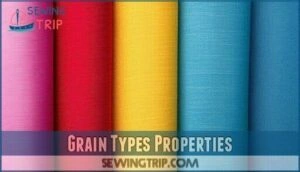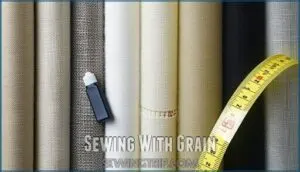This site is supported by our readers. We may earn a commission, at no cost to you, if you purchase through links.
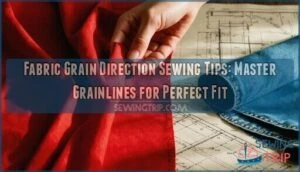
Always align pattern pieces parallel to the lengthwise grain (running alongside selvages) for stability.
For stretch, cut on the crosswise grain.
Need maximum flexibility? Cut on the bias (45° angle).
Check grain by pulling threads or folding fabric – the edges should align perfectly.
When in doubt, remember that proper grain direction prevents that annoying twist that makes garments look homemade.
Think of grain like wood – it has a natural direction that affects everything.
Master grainlines and you’ll notice improved drape, better fit, and more professional-looking garments.
Table Of Contents
Key Takeaways
- You’ll achieve professional-looking garments by aligning pattern pieces parallel to the lengthwise grain (alongside selvages) for stability, using crosswise grain for stretch, and cutting at a 45° angle (bias) when you need maximum flexibility.
- You can identify fabric grain by examining selvage edges, pulling threads, or folding fabric – proper grain direction prevents the annoying twist that makes your garments look homemade rather than handcrafted.
- You’ll need to match your grain direction to your project’s needs: use lengthwise grain for structured pieces like jackets, crosswise grain for comfortable everyday wear, and bias grain for flowy, draped garments.
- You’ll create better-fitting garments by cutting parallel to grain, matching seam lines with proper grain direction, and handling bias-cut fabric with special care (starching before cutting, using a walking foot, and letting pieces hang before hemming).
Identifying Fabric Grain
You can spot fabric grain by examining the selvage edges, testing the fabric’s stretch, or even pulling a thread to reveal its direction.
Don’t worry, it’s easier than it sounds—and once you know what to look for, your sewing projects will thank you!
Checking Selvage Edges
Selvage identification is your first step in mastering fabric grain direction.
Here’s an engaging blockquote in the same informative and enthusiastic tone as the content:
The selvage speaks first—listen to its woven wisdom for perfect grain direction every time!
These woven edges, often smooth or marked, show where the fabric was finished.
Selvages run parallel to the lengthwise grain, offering stability and guiding fabric grainline alignment.
Selvage variations, like printed or plain, help pinpoint grain direction.
Using selvages guarantees accuracy, so never cut without checking these handy fabric markers first!
Understanding the warp and weft threads is also essential for grain identification.
Using Magnifying Glass
A magnifying glass can be your best friend for fabric grain identification. It helps with Thread Identification and Weave Examination, making tiny details pop.
Inspect the fabric closely to confirm the correct grainline. Fibers and threads you might miss with the naked eye become clear, ensuring precise Grain Confirmation.
For ideal viewing, consider using a specialized viewing device. This simple tool sharpens your sewing grain tips and improves fabric grainline accuracy.
Visual Inspection Methods
Look closely at your fabric.
Selvage examination helps pinpoint the grain line direction. Check weave patterns for consistency and observe print alignment—directional prints often follow the grain.
Texture clues, like smooth or rough spots, can hint at thread orientation. Watch for density variations; tightly packed areas usually indicate lengthwise grain.
These visual inspection methods make fabric grain identification much easier.
Correcting Fabric Grain
When your fabric grain is off, it can throw your entire project out of alignment, but fixing it’s simpler than you think.
By pulling threads, making clean cuts, and giving it a proper stretch or press, you’ll get everything back on track.
Pulling Crosswise Threads
Pulling crosswise threads helps identify fabric grain for accurate cutting and prevents distortion.
To straighten fabric, follow these steps:
- Gently tug a weft thread near the fabric edge.
- Work slowly, guiding it across the fabric grainline.
- Remove bunches that form as the thread gathers.
- Verify clear thread visibility before cutting.
- Repeat until edges align perfectly!
Cutting Along Thread Line
After pulling crosswise threads to find your fabric grain, it’s time for precise fabric cutting. Follow the revealed thread-line accuracy to eliminate distortion and guarantee perfect grain alignment.
Snip carefully along the thread line, maintaining steady hands. Achieving this precision often requires specialized cutting tools.
This method minimizes fabric waste and guarantees your grain direction stays true, setting the stage for flawless grain line sewing in your projects, which is crucial for maintaining the integrity of the fabric and ensuring a professional finish with perfect grain alignment.
Folding Fabric Lengthwise
Fold the fabric lengthwise, aligning the selvage edges carefully to guarantee proper selvage alignment and grain matching.
Check that the fabric grainline stays straight while flattening it out. Pay attention to fold accuracy—misaligned edges can throw off your fabric cutting.
Understanding warp and weft threads is vital for this step.
Smooth it gently to avoid crease prevention issues, especially when working with wider fabric widths or lengthwise grain.
Ironing Folded Fabric
Set your ironing temperature based on the fabric type—low for delicates, high for cottons.
Use steam or slightly dampen fabric to control moisture levels. Smooth wrinkles by pressing firmly, not sliding, to prevent fabric distortion and maintain the grainline.
For maintaining fabric quality, consider using a specialized pressing tool.
Refold carefully using proper folding techniques, ensuring edges align. This prevents creases and keeps your fabric grain perfect for sewing projects.
Grainline Importance
Grainlines are the secret to sewing garments that hang right and feel comfortable.
When you follow them, your fabric drapes beautifully, fits properly, and doesn’t twist like a stubborn shoelace.
Fabric Drape and Stretch
Fabric grain hugely impacts drape and stretch.
Bias drape creates flowing, delicate shapes, while lengthwise grain provides structure.
With woven drape, the fabric falls neatly, perfect for bespoke looks.
For knit stretch, focus on stretch percentage, making activewear comfy.
Grain manipulation is like guiding fabric’s personality—get it wrong, and instead of elegance, you might’ve chaos!
Garment Fit and Behavior
How fabric grain aligns directly affects garment fit and how fabric behaves over time.
Misaligned grain can lead to distorted seams or awkward drape.
To avoid fit issues and guarantee seam stability, follow these steps:
- Always check fabric grain before cutting.
- Align the grainline with patterns.
- Avoid stretching or pulling bias cuts.
- Match seams carefully.
- Test fit after sewing to ensure a proper fit.
Pattern Alignment Considerations
When aligning patterns, grainline markings are your compass.
Straight grain guarantees grain stability, so position pieces parallel for fabric efficiency and design integrity.
A thoughtful pattern layout helps maintain seam matching and avoids twisting seams.
Don’t rush fabric cutting; a misstep can ruin alignment.
Precision here preserves the balance between fabric grain and flawless garment construction.
This attention to detail is crucial for achieving professional results, emphasizing the importance of precision in every step of the process.
Fitted Garment Requirements
When sewing fitted garments, grain alignment isn’t just a detail—it’s your secret weapon for success.
Ensuring perfect grain direction improves seam stability and pattern precision.
This keeps curves smooth and shapes sharp.
Ignoring grainlines? Risk twisted seams or poor garment fitting.
For sewing accuracy, trust shaping techniques that respect fabric grain and make fabric choice an ally, not a challenge, using shaping techniques that improve seam stability.
Grain Types Properties
Every fabric grain has its own strengths, from the stability of the lengthwise grain to the stretch of the bias.
Understanding these properties helps you choose the right direction for a project that fits and moves just right, utilizing the stretch of the bias for optimal results.
Lengthwise Grain Stability
The lengthwise grain, or straight grain, runs parallel to the selvage edges, offering unmatched stability.
Thanks to the warp thread strength, this grain resists stretching, making it perfect for structured garments like pants or blazers.
Understanding grain direction importance here guarantees precise pattern placement and a professional finish.
Fabric weight considerations impact the drape and durability of the final product.
Always check the fabric grain to maximize stability in your projects.
Crosswise Grain Flexibility
The cross grain, defined by the weft thread properties, brings moderate fabric stretch, making it great for garment comfort.
Always perform a stretch test to assess flexibility and guarantee accuracy.
Cross-grain applications often suit casual clothing, as it allows more give than the lengthwise grain.
Understanding fabric manipulation here guarantees balanced fabric grain behavior and better fit.
Bias Grain Stretch
Bias grain stretch makes fabric behave like a dancer—graceful but unpredictable. It offers maximum stretch and beautiful bias drape, perfect for shaping garments.
But be cautious:
- Bias cutting can lead to distortion if not handled carefully.
- Seams might stretch, so practice stretch control.
- Hem edges demand extra attention to prevent fabric from warping.
Handle bias grain gently!
Choosing Grain Direction
How do you decide which grain direction to use for your sewing project? Consider your fabric type and project goals first.
For structured jackets, choose stable lengthwise grain. For flowy skirts, bias grain creates beautiful fabric drape.
Match your pattern layout to your garment style—crosswise grain offers moderate stretch for comfortable everyday wear. The grainline marker on your pattern provides guidance, but you can adjust based on your creative vision.
Sewing With Grain
You’ll notice a dramatic improvement in your projects when you cut and sew with the grain instead of fighting against it.
Working with the correct grain direction prevents your garments from twisting like a pretzel after washing and guarantees they’ll hang beautifully on your body.
Cutting Parallel to Grain
Every successful sewing project begins with proper fabric grain alignment during cutting. When you position your pattern pieces parallel to the grain direction, you’re setting yourself up for professional results.
- Use grain alignment tools like clear rulers to guarantee accurate pattern placement
- Secure fabric with weights rather than pins to avoid distortion
- Consider your cutting table setup—a level surface prevents stretching
Keep fabric flat and properly aligned for the perfect fit.
Matching Seam Lines
The secret to professional-looking garments lies in matching your seam lines to the fabric’s grain direction.
When you align seams with proper grain, you’ll prevent those frustrating twisted seams that scream "homemade."
Consistent seam drape depends on careful grain alignment, especially where pattern matching matters.
Think of seam grain alignment as the invisible foundation that keeps your projects looking polished—even after washing and wearing.
It’s worth the extra minute to check, as this attention to detail will ensure your garments have a polished look.
Using Lengthwise Grain
Structural integrity depends on your strategic use of lengthwise grain. When you’re working with pieces that need stability, like waistbands or jacket fronts, position pattern pieces parallel to the selvage.
Warp threads running along this grain provide maximum strength with less stretch, ensuring your garment maintains its shape. For vertical alignment on fitted pieces, lengthwise grain is your best friend—it’s why tailors always align suit jackets this way!
Proper alignment helps prevent seams from puckering.
Working With Bias Grain
While lengthwise grain provides structure, bias grain offers exciting possibilities.
When working with bias grain, cut fabric at a true 45-degree angle to the selvage for maximum stretch and fluid drape.
Starching fabric before cutting helps prevent distortion. Use a walking foot, reduce presser foot pressure, and lengthen stitches slightly when sewing bias seams.
Handle bias-cut pieces gently and let them hang before hemming to allow natural stretching.
Frequently Asked Questions (FAQs)
How to tell which way the fabric grain is going?
The proof is in the pattern.
You’ll find grain by checking selvage edges (lengthwise runs parallel), testing stretch (crosswise has more give), or pulling a thread to create a clear line that follows the grain direction.
How do you know which direction to cut fabric?
Cut fabric following the pattern’s grainline arrows, which should align with the selvage edge.
You’ll get the right stretch and drape for your project, and your finished garment won’t twist awkwardly when worn.
Is fabric grainline parallel to selvage?
Ever wondered about perfect fabric alignment?
Yes, the lengthwise grainline runs exactly parallel to the selvage edge.
This is your fabric’s most stable direction with minimal stretch, ideal for structured garment pieces you’re creating, following the lengthwise grainline for stable direction.
How does grain affect different fabric types?
Grain impacts how your fabrics behave during sewing and wearing.
Woven fabrics follow grain strictly, while knits are more forgiving.
You’ll notice differences in stretch, drape, and stability depending on grain direction.
Can knit fabrics have grain direction?
While 72% of sewists focus only on woven grain, knits absolutely have grain direction. You’ll find lengthwise grain (most stable), crosswise grain (stretchier), and bias direction in your knit fabrics too.
How to match plaids along grain lines?
For perfect plaid matching, align prominent lines with the grain and pin excessively.
You’ll want to match horizontal and vertical patterns at seams, marking matching points before cutting.
It’s tedious but worth the professional results, as this process ensures a high-quality finish with perfect plaid matching.
Does fabric grain affect pattern matching?
Yes, fabric grain absolutely affects pattern matching.
You’ll need to align your pattern pieces with the grain to guarantee prints, plaids, and stripes match properly at seams.
Ignoring grain direction can create misaligned patterns that appear unprofessional, which is why understanding grain direction is crucial.
When should you intentionally cut off-grain?
You’ll want to cut off-grain when creating garments with intentional drape or bias effects.
Designing circular skirts, or working with specialty fabrics where the diagonal stretch enhances fit and movement in your finished piece, are also situations where cutting off-grain is beneficial.
Conclusion
Remember Sarah’s wrap dress that twisted awkwardly after washing? That’s what happens when you ignore fabric grain direction sewing tips.
By aligning your patterns with the proper grainline, you’ll create garments that hang beautifully and last longer.
Whether you’re cutting on lengthwise grain for stability, crosswise for stretch, or bias for drape, these techniques make the difference between "homemade" and "handcrafted".
You’ve got the knowledge now—your next project will showcase your newfound mastery of grainlines.

